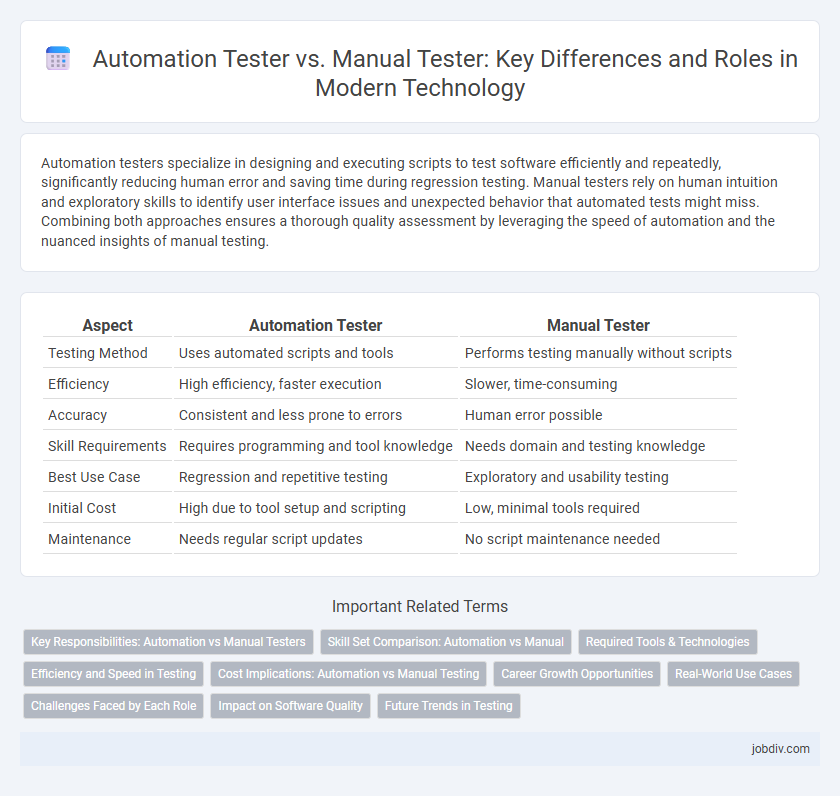Automation testers specialize in designing and executing scripts to test software efficiently and repeatedly, significantly reducing human error and saving time during regression testing. Manual testers rely on human intuition and exploratory skills to identify user interface issues and unexpected behavior that automated tests might miss. Combining both approaches ensures a thorough quality assessment by leveraging the speed of automation and the nuanced insights of manual testing.
Table of Comparison
| Aspect | Automation Tester | Manual Tester |
|---|---|---|
| Testing Method | Uses automated scripts and tools | Performs testing manually without scripts |
| Efficiency | High efficiency, faster execution | Slower, time-consuming |
| Accuracy | Consistent and less prone to errors | Human error possible |
| Skill Requirements | Requires programming and tool knowledge | Needs domain and testing knowledge |
| Best Use Case | Regression and repetitive testing | Exploratory and usability testing |
| Initial Cost | High due to tool setup and scripting | Low, minimal tools required |
| Maintenance | Needs regular script updates | No script maintenance needed |
Key Responsibilities: Automation vs Manual Testers
Automation testers develop and maintain automated test scripts using tools like Selenium and Appium to increase testing efficiency and coverage. Manual testers execute test cases manually, focusing on exploratory, usability, and ad-hoc testing that requires human judgment and intuition. Key responsibilities for automation testers include scripting, debugging, and maintaining test automation frameworks, while manual testers concentrate on detailed test case design, requirement analysis, and documenting defects.
Skill Set Comparison: Automation vs Manual
Automation testers require advanced programming skills in languages like Java, Python, or C#, along with expertise in automation tools such as Selenium, QTP, or TestComplete to develop, execute, and maintain automated test scripts. Manual testers emphasize strong analytical skills, attention to detail, and a deep understanding of application workflows to identify defects through exploratory, usability, and ad-hoc testing without relying on scripts. While automation testers focus on scalability and repeatability of test cases using continuous integration systems, manual testers excel in detecting unexpected issues requiring human intuition and adaptive assessment.
Required Tools & Technologies
Automation testers require proficiency in programming languages like Java, Python, or C# and expertise in automation tools such as Selenium, QTP, or TestComplete to develop and execute test scripts. Manual testers primarily rely on test management tools like JIRA, TestRail, or Quality Center to design test cases and track defects, emphasizing exploratory and usability testing without coding. Both roles benefit from knowledge of CI/CD tools such as Jenkins and version control systems like Git to ensure seamless integration and collaboration in the software development lifecycle.
Efficiency and Speed in Testing
Automation testers significantly enhance testing efficiency by executing repetitive test cases at high speed using scripts and tools, reducing the overall testing time compared to manual testers. Manual testers, while essential for exploratory and usability testing, often require more time to identify issues due to the slower, human-driven test execution process. Automated testing frameworks like Selenium and Appium provide scalable and rapid test coverage, allowing faster feedback loops and quicker releases in continuous integration environments.
Cost Implications: Automation vs Manual Testing
Automation testing requires higher initial investment in tools and script development but reduces long-term costs by enabling repeated test execution with minimal human intervention. Manual testing incurs lower upfront expenses but increases overall costs over time due to labor-intensive processes and slower test cycles. Organizations often achieve cost efficiency by combining automated testing for regression and repetitive tasks with manual testing for exploratory and usability assessments.
Career Growth Opportunities
Automation testers experience faster career growth due to high demand for skills in scripting languages, test automation frameworks, and continuous integration tools. Manual testers can advance by specializing in niche domains or transitioning into automation roles to enhance their technical expertise. Organizations increasingly prioritize automation testing, making expertise in automated tools critical for leadership and senior-level positions.
Real-World Use Cases
Automation testers excel in repetitive and large-scale regression testing, deploying scripts to quickly validate application functionality across multiple environments, which significantly reduces testing time and human error. Manual testers are essential for exploratory, usability, and ad-hoc testing scenarios where human intuition and user experience insights identify subtle issues automation might miss. Industries like finance, healthcare, and e-commerce leverage automation testers for continuous integration pipelines while relying on manual testers to assess new features' real-world usability and compliance.
Challenges Faced by Each Role
Automation testers face challenges such as maintaining and updating test scripts to keep pace with rapid software changes and managing complex test environments requiring robust programming skills. Manual testers encounter issues with repetitive test execution, which can lead to human error and decreased efficiency in large-scale projects. Both roles require continuous learning to adapt to evolving technologies and ensure comprehensive software quality assurance.
Impact on Software Quality
Automation testers use advanced scripting and testing tools to execute repetitive and complex test cases with high precision, significantly reducing human error and accelerating defect detection. Manual testers provide critical user experience insights and exploratory testing that uncover usability issues and unpredictable bugs not easily caught by automated scripts. Combining automation testing's efficiency with manual testing's nuanced analysis leads to comprehensive software quality assurance and improved product reliability.
Future Trends in Testing
Automation testers are increasingly in demand due to the rise of AI-powered testing tools and continuous integration pipelines enhancing test efficiency and coverage. Manual testers remain crucial for exploratory testing and user experience validation, areas where human intuition and creativity are irreplaceable. Future trends indicate a hybrid approach, integrating AI-driven automation with skilled manual testers to deliver comprehensive and adaptive testing strategies.
Automation Tester vs Manual Tester Infographic

 jobdiv.com
jobdiv.com